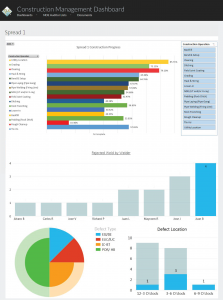February 2016, Vol. 243, No. 2
Features
Mobile Inspection Forms Cut Time, Maximize Accuracy of Audits

Recordkeeping increasingly is the linchpin for the safe, reliable construction and operation of energy pipeline systems. In both the aftermath of natural gas pipeline incidents and in the attempts to develop a more sophisticated safety culture that employs technology advances to expand preventive maintenance, accurate, up-to-date and accessible inspection records are a risk-management necessity. This has required a technology and a mindset transformation of sorts for the oil and gas industry.
Emerging from more recent federal and state regulatory responses to pipeline failures, some catastrophic in their effects, there has been a renewed emphasis on the “paper trail” of inspection, maintenance and original construction records. Too often, the post-disaster investigations turn up gaps or incorrect citations in the information. On the surface, it appears the industry needs to undergo more extensive “paper chases,” but in truth, operators need to work smarter.
Traditionally, Herculean efforts have been launched rounding up ever-larger volumes of documentation in response to cries for better recordkeeping. The ability to identify and verify facts about the history of a given pipeline segment becomes an all-out effort.
Often, that has meant focusing more and more people on a documentation project, but the effort to generate more information through devoting more workers to the challenge can increase the chances for human error. These efforts sometimes result in compromised information that is vulnerable to legal and regulatory challenges.
It may seem counterintuitive to operators and regulators alike, but the goal is to create less paperwork while providing more reliable and timely data, freeing up experienced chief inspectors to spend more time observing operations and not trying to standardize and cross-check the accuracy of their documentation.

That is where firms like Metairie, LA-based Project Consulting Services (PCS®) come in, offering software solutions that change the whole inspection role from one of documentation to a faster, real-time task of data collection. PCS has focused on pipeline and related energy construction projects for its tool, Mobile Inspection FormsTM (MIF), but it is applicable to operations in which the recordkeeping for safety/reliability testing makes it imperative the chances of human error can be virtually eliminated.
“The technology is available to any inspection project, but we believe it is critical to the future of pipeline construction and have incorporated it into all PCS inspection projects at no additional cost when using our inspectors,” said Buddy Belcher, PCS inspection manager.
What PCS and other providers of mobile platforms attempt to do is make them supportable for various mobile-operating systems from Apple iOS, Android and Windows tablets, among other devices. Field inspectors can leave their laptops in the truck or office. Operators are more frequently looking for a standalone mobile tool that all inspectors can deploy effectively on any particular project. They want to ultimately depend on their own resources without needing to retain a third party to implement the paperless system.
“It is definitely an important feature of construction now, mainly in terms of documenting the as-built conditions of pipelines,” said Max Toch, lead at the Pipeline Research Council International’s Design, Materials and Construction Committee. Toch calls himself an “office guy” who can look at the new technology from a theoretical standpoint and “see huge value.”
“It is definitely something that is going to be industry-wide shortly,” said Brett Greenwalt, a seasoned inspector, who worked last fall with San Antonio, TX-based Patriot Inspection on a 24-inch gas pipeline expansion project by Energy Transfer Partners in the Marcellus. “It is easy for an organization as a whole to chart the progress of a job.”
Personally, Greenwalt’s initial experience with the system was not good, but he said within a short time he fully embraced it. “In a few weeks, I began to depend on it; I love it.” As he stands back now, Greenwalt said his initial negativity was simply because “it was different” and he was resisting the change at first. ‘It [the start-up problem] was more me than anything; I had to learn something different.”
He and a Patriot colleague, welding inspector Russell Plantt, said they feel they have used the mobile recording devices as part of a first-time use at Energy Transfer. As such, they supplied a lot of feedback that allowed changes and permitted the midstream company to better adapt the technology to its unique methods of operations. They were not causing changes in the technology’s functionality, only in its adaptation, and in that sense the initial use of MIF was a beta test for Energy Transfer. Ultimately, the software has proven flexible and adaptive, they say.
“For me, it is time and efficiency,” said Plantt, a 20-year pipeline veteran who has been an inspector the past three years. “Everything is addressed in the system from welding procedures and safety requirements. If there is something that changes you’re able to download photographs into the report. That’s a real time-savings aspect, and that helps your chief and his boss.”
While most regulators in 2016 are still not requiring real-time data even though it can be readily produced, these same regulators are more than ever focused on accuracy and completeness in pipeline records. Just ask a major utility such as San Francisco-based Pacific Gas and Electric Co. (PG&E) learned last fall when it was called out by the California Public Utilities Commission (CPUC) for repeated recordkeeping problems that compromised the multibillion-dollar combination utility’s natural gas pipeline safety. At year-end it was facing possible fines and penalties.

Mobile forms can minimize, if not eliminate, this sort of problem from developing. “Regulators do not require the real-time nature of data, but the real-time nature allows for more expedient quality checks that ultimately result in improvements in what the regulators do require – accuracy, completeness and quality,” said PCS’s Brett Vogt.
In the right hands, the mobile-inspection forms (MIF) can both speed operations and decision-making on a variety of projects, including hydrostatic testing of pipelines. In an environment that is data-driven rather than documentation-focused, the inspection results will be complete, and there should be no “missed” problems as have been the case in the pipeline autopsies that have followed major incidents in North America in recent years.
One industry expert told PGJ that “monitoring” data, as opposed to eyes-on-documents, “allows for a much more consistent reporting of any value that passes a problem threshold.” In other words, forms that identify nonconformance issues can be specifically routed or escalated immediately upon submittal to personnel who should be notified and take action immediately.
Travis Gross, project manager with Energy Transfer, is another veteran who thinks MIF is destined to be used industry wide, given his experience with the technology since mid-2015 on gas pipeline gathering projects he is working on in the Marcellus. Little features such as the clarity and spell check applied to working inspection documents is “huge,” along with having real-time access to all the data bases as opposed to paper files, Gross said.
“If I have to search something, it is a lot easier to find with all of the data base connections,” he said. “Otherwise, I would be going through paper after paper.” He noted that many people in the inspection corps are longtime workers who didn’t grow up using computers, but nowadays everyone has a smart phone, so they are adapting pretty quickly to the MIF use. “I think it is easier with iPads than having to do it on a computer,” said Gross, adding that none of the 40-plus inspectors he deals with have voiced any concerns.
An assistant chief inspector, Buddy Kness, remembers a 22-inch pipeline construction project in which MIF cut his office time from up to two hours to under 20 minutes, freeing him for more time in the field to view the construction work first-hand. Without the mobile forms, he encounters “endless emails back and forth.” With the MIF, as soon as the inspectors hit the “complete” button, full error-free reports come to him, said Kness, noting he saves time by not having to fact-check everything.

“It cuts out a lot of time and energy for me. Where I used to look at being in the office for two hours or more, it is now down to a half hour or less. That’s the benefit to me; it gets me out to the field much faster to actually do the job I was hired to do.”
Noting that all of the inspectors he works with have transitioned to the new technology – “even the veterans” – Kness noted that tracking of work runs from station to station with the MIF automatically calculating the footage covered between each station. The inspector does not have to calculate the distances. A variety of dropdown options in the system helps eliminate the possibility of human error.
“It is important that the welding inspector pay close attention to daily monitoring of nondestructive examination (NDE) activities being performed during pipeline projects to keep NDE activities on track and within code requirements,” according to David Culbertson, writing on the American Welding Society’s website. In an article he wrote based on actual field results obtained during audits of several large and small pipeline projects, he said, “The results of these audits were alarming,” offering examples and tips on what inspectors should look for when conducting audits.
While noting that only nationally certified inspectors should do NDE work, Culbertson said a record of the NDE personnel’s certification should be maintained on file by the pipeline operator. “The record shall include results of NDE certification tests, the agency and person granting certification and the date of certification.”
MIFs when applied properly provide more than raw data. They apply proprietary technology and calculations to provide automated construction progress tracking and various projections regarding completion dates, budget overruns and quality information on the percentage of welds that passed NDE. This is particularly critical on large-scale construction projects. Spatial data is also published in a true geographic information system (GIS).
With the dropdowns in the MIF format, welding inspector Plantt said users can zero in on the given tasks for a particular day – tie-in welds, mainline welds; a mini-gang or pipe gang work or reporting X-rays within the daily work. The form calls out what is actually being performed within certain job tasks, he said. “All peoples’ suggestions and recommendations were adopted and implemented during the integration of the new tool.”
Users of the technology stressed the need to download the relevant software to any device to replace outdated, inefficient paper forms for inspection processes. This in turn should enable any organization to complete more inspections, increase the accuracy and volume of real-time data, and do so with or without Internet connectivity. They should work with on-premises or cloud support, integrating with existing data bases, some of the competing, suppliers say. In addition to the energy sector, government, manufacturing, life science and various field services companies are adopting the technology.
Firms such as PCS note that operators using Word, Excel and email for all of their recordkeeping procedures should be aware that those applications are not state-of-art. In fact, in the software world, what constitutes state-of-the-art is changing constantly. That’s why there is no so-called “silver bullet” solution, only a need to be constantly improving and testing data and systems.
“As information technology is not often a core competency of a pipeline operating company, it is valuable for operators to partner with other companies that have both a deep knowledge of the energy industry and software solutions that are regularly updated to achieve a balance between state-of-the-art versus robust and reliable,” said PCS’s Vogt.
Richard Nemec is PGJ West Coast Contributing Editor in Los Angeles. He can be reached at rnemec@ca.rr.com.





Comments